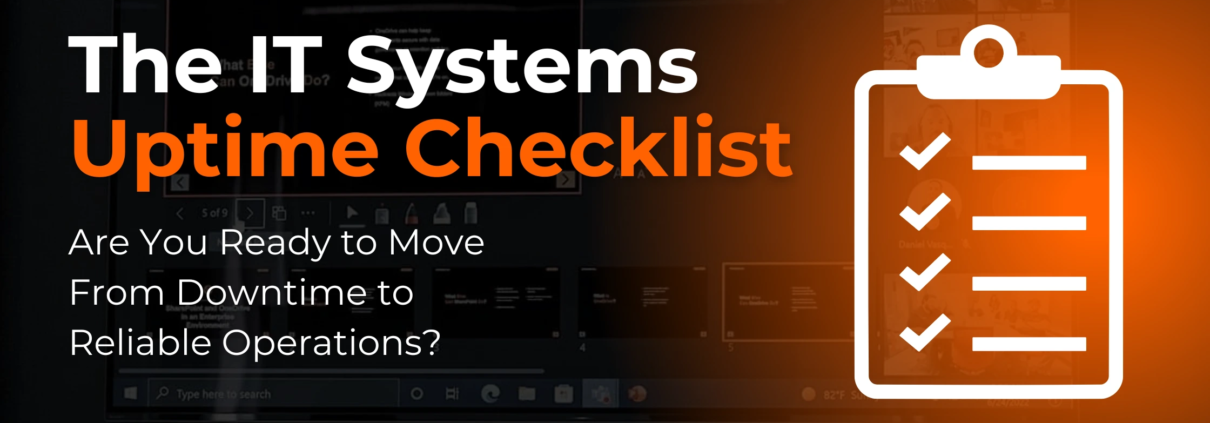The IT Systems Uptime Checklist: Are You Ready to Move From Downtime to Reliable Operations?
Downtime is more than an inconvenience. It costs time, money, and trust. Every minute your systems are offline can mean missed opportunities, frustrated customers, and burned-out teams trying to recover.
The good news is that downtime is preventable. With the right systems, habits, and partners, your technology can be a source of confidence, not stress.
If you want to take a deeper look at the causes and consequences of downtime, read our full guide: From Downtime to Uptime: The Importance of Reliable IT Systems.
This checklist will help you understand:
- Where your reliability risks really lie
- How prepared your systems (and people) are
- What steps can move your business from reactive to reliable
Grab a pen or open a notepad, and let’s find out how your IT setup really stacks up.
1. Check Your Current Risk
These are the red flags that most businesses overlook until something breaks.
☐ We’ve had more than X unplanned IT outages in the last 12 months.
☐ We track average downtime hours per outage.
☐ We have visibility into which systems or vendors cause the most downtime.
☐ Our IT team spends more time reacting than planning.
☐ We’ve had at least one network or server failure without a documented root cause.
☐ We’ve experienced a security incident or data breach that interrupted operations.
If you checked two or more boxes here: your systems are likely reactive instead of resilient. It’s time to move from firefighting to foresight.
2. Check the Business Cost and Impact
Every minute of downtime affects more than operations. It affects people and trust.
☐ We know our cost per hour of downtime (lost revenue, productivity, and reputation).
☐ We track customer complaints or churn related to service interruptions.
☐ Downtime has disrupted our ability to meet client or vendor commitments.
☐ Our IT budget includes recovery costs, not just regular operational expenses.
If you checked one or more boxes here: your downtime has already become a business issue, not just a technical one. Understanding the cost of inaction is the first step toward real change.
3. Check Your Reliability Controls
Reliable systems are not built by luck. They are built with intention and layers of protection.
☐ We have redundant servers and network devices in place.
☐ We use automated monitoring tools that alert our team before a failure occurs.
☐ We have documented failover and disaster recovery procedures.
☐ We schedule proactive maintenance like patching and backups.
☐ We have clear communication protocols for staff and clients during downtime.
☐ We test our backup and recovery systems at least once a year.
If you scored low here: your systems may appear fine but could fail without warning. True reliability comes from structure, testing, and a culture of prevention.
4. Check Your Readiness to Scale and Future-Proof
Even if your systems are stable today, growth brings new challenges. Can your IT environment grow with you?
☐ We have an IT roadmap that aligns reliability with business goals.
☐ We manage vendors to avoid single points of failure.
☐ We budget for system upgrades, redundancy, and monitoring.
☐ We regularly review dependencies on cloud, SaaS, or remote work tools.
☐ We have a trusted IT partner who audits system reliability and security.
If you left most of these unchecked: your business may be growing faster than your systems can handle. Without the right foundation, scalability becomes fragility.
How to Understand Your Results
Count how many boxes you checked across all sections, then see where you stand.
0–5 checks: You’re in a strong position. Keep refining your maintenance schedule and monitoring tools to stay proactive.
6–10 checks: You’re at moderate risk. Some of your systems are reliable, but hidden weaknesses could lead to unexpected outages.
11+ checks: Your business is operating reactively. The good news? You have clear starting points for improvement, and expert support can make change faster and smoother.
Building Confidence with Reliable IT
Downtime is not inevitable. It’s a signal that something in your environment needs attention. Reliable IT systems reduce that risk and give your business the stability it needs to grow with confidence.
When your IT runs smoothly, your team can focus on what matters: serving clients, meeting goals, and planning ahead instead of putting out fires.
Partnering with SYSTEMSEVEN
At SYSTEMSEVEN, we help Texas businesses move from reactive fixes to proactive reliability. Our onboarding process is calm, structured, and designed to reduce stress for your team while improving long-term uptime.
Whether you are in Austin, Corpus Christi, or anywhere across Texas, we provide the tools, monitoring, and support your business needs to stay reliable and resilient.
If this checklist revealed more risk than you expected, let’s take the next step together.
Start your IT reliability assessment today. We’ll help you identify your risks, strengthen your systems, and build a foundation you can trust.

